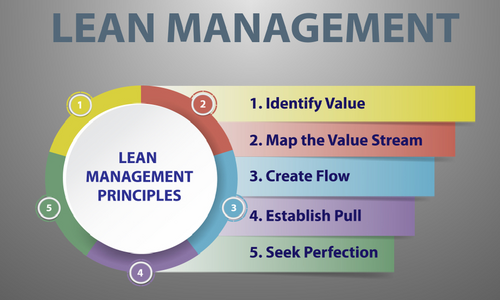Due to growing competition, organizations should find a means to enhance their operations and maximize value while eliminating waste. This is where adopting Lean management becomes crucial. Lean management prioritizes increasing customer value while reducing process waste. It aids businesses in transforming their operations, developing a culture of constant improvement, and gaining a competitive edge.

Jump ahead to
Definition of Lean Management
Lean management is a philosophy and approach that originated from the Toyota Production System (TPS). It emphasizes maximizing value for customers while reducing process waste. Furthermore, it aims to eliminate waste of time, effort, or money by identifying each stage in a business process and then modifying or eliminating areas that do not add value. Lean management entails a great deal of process analysis, integrating viewpoints from diverse organizational leaders and mapping the processes that provide value to the business. Moreover, the Lean concept applies to all business and production processes, from manufacturing to healthcare, engineering, and software development.
5 Principles Of Lean Management
Lean management revolves around these core principles, which act as the guidelines to implement the lean methodology in an organization. The five principles are the following:
Identify Value
The value lies in finding the customer’s problem and making the product the solution. The product must be the solution component that the consumer can afford and is willing to pay for. Any additional process or action that doesn’t add value to the final product considered as waste. Value identification is the first step in the lean process. Organizations should decide what they want to deliver first and then proceed to the following phase. Businesses may find out what their consumers value using surveys, interviews, demographic data, and web analytics.
Value Stream Mapping
Value Stream Mapping is the method used to visualize a company’s workflow. It encompasses every process and participant in producing and distributing the final product to the customer. Value stream mapping aids in locating process phases that do not add value. It also demonstrates where value is being created and how much each process step adds value. Value stream mapping enables companies to see which teams are responsible for which processes and to identify those in charge of monitoring, analyzing, and optimizing those processes.
Create a Continuous Workflow
The next step after eliminating the waste from the value stream is establishing a continuous process. It entails ensuring that each team’s process proceeds without interruption and avoiding any bottlenecks or delays that might result from cross-functional collaboration. The company has to keep an eye on how the work moves through its process. Pay special attention to any areas where work frequently becomes stalled. There are several ways to ensure value-adding activities go smoothly, including cutting down stages, reorganizing the production steps, balancing the workload, developing cross-functional departments, and teaching staff to be multi-skilled and adaptable.
Create a Pull System
A stable workflow guarantees teams can deliver tasks much faster with less effort. However, when it comes to the Lean approach, set up a pull system to ensure a consistent workflow. Creating a pull system guarantees that the continuous workflow is reliable and that teams complete tasks more quickly and with less effort. It also guarantees that new work is only begun if needed, which reduces overhead and maximizes storage costs.
Continuous Improvement
The above four steps aid organization in developing a lean management system. However, They must focus on this final step, which is the most crucial one. The lean management system is neither isolated nor unchanging; therefore, issues may occur within any of the other four steps. Continuous improvement includes a variety of techniques that assist a company in determining what it has done, what it needs to accomplish, potential impediments, and methods for all employees to enhance their work processes. Additionally, it ensures that every person contributes to the ongoing enhancement of the workflow, which safeguards the business if issues arise.
Conclusion
Due to its emphasis on streamlining every component of a work process and including every level of a company’s hierarchy, lean concepts are becoming a growing trend. It offers a systematic strategy to promote organizational excellence by emphasizing value, waste minimization, ongoing improvement, and employee involvement. Moreover, continuous improvement serves as the foundation of lean management. This enables businesses to adapt to shifting market conditions and maintain their competitiveness over a prolonged period.
Professionals interested in learning about lean management can enroll in Lean Foundation Training. They learn about all aspects of lean management and how these principles apply in real-life settings. Also, they assist organizations in identifying, analyzing, and eliminating the different types waste in their quality processes. The course further introduces them to process mapping, KAIZEN, and 5S. This knowledge helps professionals start a career in Quality management and contribute to the overall success of organization.
Summary:
Lean management is a way of working that cuts out anything that doesn’t add value while putting customer needs first. It originates from the Toyota Production System and focuses on reducing waste in time, effort, and cost. The approach is built on five key principles: identifying what customers truly value, mapping the value stream, creating smooth and continuous workflow, setting up a pull system where work begins only when needed, and encouraging continuous improvement. By visualizing processes and removing unnecessary steps, organizations can reduce waste and operate more efficiently. This approach also motivates everyone from leadership to frontline teams to contribute to ongoing improvements. Check out our Lean Management Certification Training if you want to strengthen your lean skills and apply this mindset in real projects.
FAQs About Lean Management:
1. What are the 5 principles of lean management?
The five principles focus on defining customer value, mapping processes, creating smooth flow, producing based on demand, and continuously improving. Together, they help organizations remove waste and deliver value faster.
2. What are the 5S principles of Lean?
5S includes Sort, Set in Order, Shine, Standardize, and Sustain to maintain an efficient and clutter-free workplace. It builds discipline and ensures every tool or activity has a clear purpose.
3. What are the 5 C’s of Lean?
The 5 C’s aim to clean out unnecessary items, arrange essentials, maintain workspace cleanliness, follow standards, and keep the system consistent. These steps help teams stay organized and reduce mistakes.
4. What are the 4 C’s of Lean?
The 4 C’s highlight customer focus, continuous improvement, collaboration, and culture. These areas ensure Lean is adopted not just as a process but as a mindset.
5. What are the 4 pillars of Lean?
Lean often stands on pillars like Continuous Improvement and Respect for People, supported by long-term thinking and problem-solving. These pillars guide teams to improve sustainably and responsibly.
6. What is the goal of lean management?
Lean aims to remove waste, streamline processes, and improve the value delivered to the customer. It helps organizations work smarter, not harder.
7. What is considered “waste” in Lean?
Waste refers to activities that don’t add value, such as waiting time, extra motion, unnecessary steps, or defects. Lean removes these barriers so work flows smoothly.
8. How does 5S support lean management?
5S creates a clean, organized, and predictable workspace, making flaws easier to spot and reducing downtime. It sets the foundation for a reliable Lean environment.
9. What is value stream mapping in Lean?
Value stream mapping visualizes every step in a process to identify delays, duplications, and waste. It helps teams redesign workflows for better efficiency.
10. How does Lean improve customer value?
Lean focuses on understanding what customers truly need and removing anything that doesn’t help deliver that need. This ensures faster, higher-quality, and more relevant outcomes.
11. Is continuous improvement necessary in Lean?
Yes, Lean relies on small daily improvements that keep processes evolving and prevent bottlenecks from returning. This ongoing effort builds long-term performance and adaptability.
12. How does lean management benefit organizations?
Lean reduces costs, shortens process time, enhances quality, and increases employee involvement. It makes operations more predictable and customer-centric.



